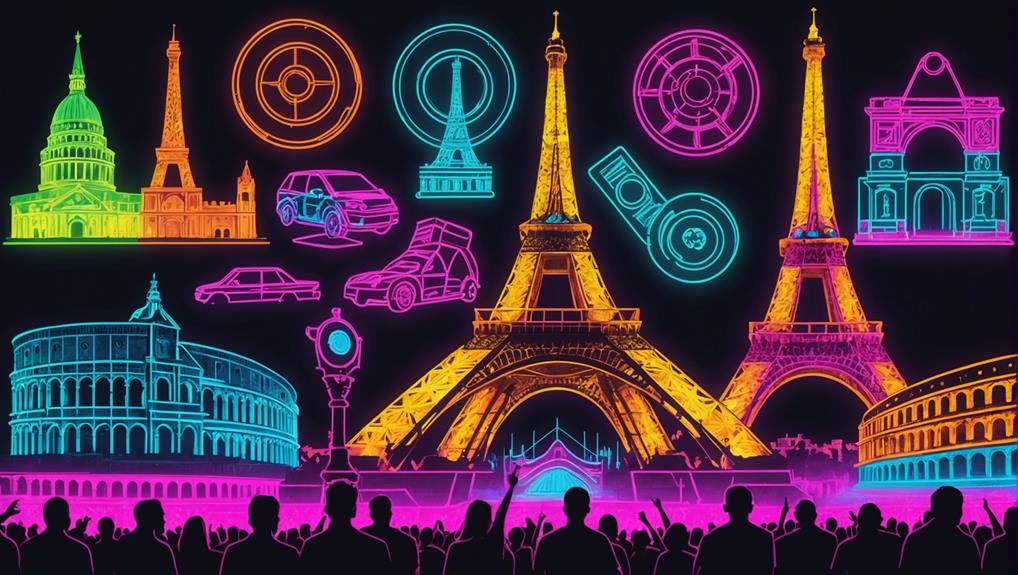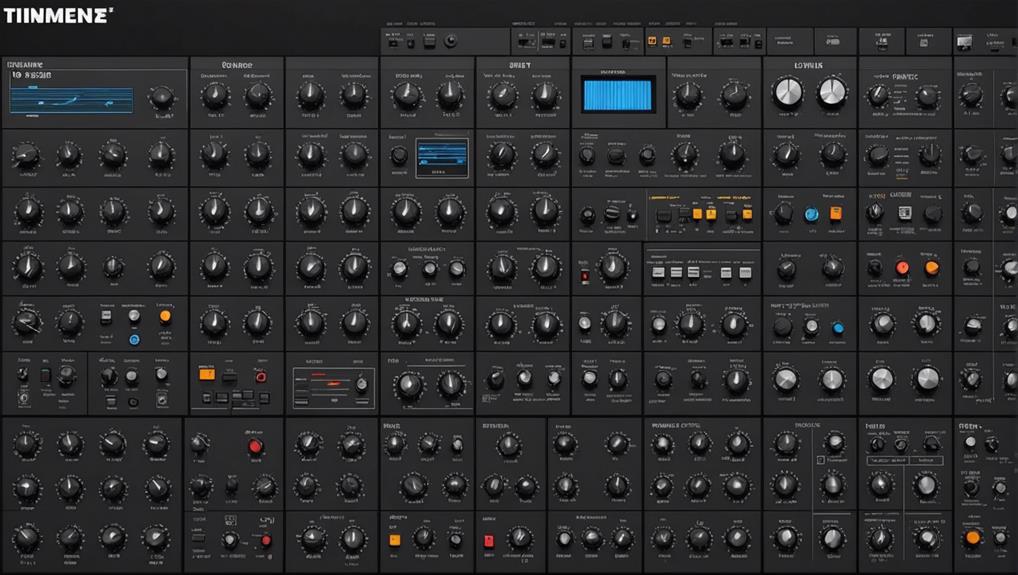No products in the cart.
You’ve noticed techno and trance both pump up the dance floor, but they’re distinct. Techno, born in Detroit, thrives on industrial beats and minimal vocals, creating hypnotic, gritty rhythms typically set between 120-150 BPM. Trance, on the other hand, emerged from Europe, blending rich melodies and ethereal vocals that aim for spiritual highs. With its BPM also between 125-150, trance emphasizes emotional crescendos and often experiments with varying time signatures, crafting dynamic soundscapes. Culturally, techno reflects Detroit’s mechanical landscape, while trance channels European euphoria. Each style caters to unique spiritual and auditory experiences, paving ways for their evolving subgenres. There’s much more to uncover about how these differences influence their respective music scenes.
Contents
hide
Key Takeaways
- Techno focuses on rhythmic elements with minimal melody, while Trance emphasizes rich melodies and chord progressions.
- Techno has a gritty, industrial sound reflective of Detroit’s urban landscape; Trance offers ethereal, uplifting soundscapes influenced by European classical music.
- Techno typically maintains a 4/4 time signature for a steady, driving beat; Trance explores varied time signatures, creating dynamic rhythmic landscapes.
- Techno uses few vocals and aims for a hypnotic listening experience; Trance frequently incorporates vocals and aims for emotional and spiritual elevation.
- Techno’s themes often revolve around urban energy and rebellion; Trance themes are centered on euphoria, escape, and emotional depth.
Origins and Historical Development
While techno emerged from the urban landscapes of Detroit, drawing on funk, jazz, and industrial music, trance developed in Europe in the 1990s, incorporating elements of classical, ambient, and house music. This divergence in their origins isn’t just a tale of different sounds; it’s a reflection of how deeply a genre’s birthplace shapes its character.
In Detroit, techno was the revolutionary output of a city steeped in automotive industry and Motown‘s rhythmical legacy. It’s where historical and cultural dynamics transformed electronic music into a gritty, mechanistic vibe that moved bodies. Here, geographical influences were direct: the harsh, repetitive work environments mirrored in the relentless beats of tracks like ‘No UFOs’ by Model 500.
Across the ocean, trance music’s evolution took a different path. European artists, influenced by the continent’s rich classical heritage and emerging rave culture, infused their tracks with sweeping, hypnotic sounds designed to uplift the mind rather than just the feet. Songs like ‘What Time Is Love?’ by The KLF showcased a blend that wasn’t only about rhythm but also mood and atmosphere, highlighting how geographical influences subtly but powerfully dictate the musical evolution of a genre.
Tempo and Rhythm Variations
Exploring the tempo and rhythm variations between techno and trance reveals distinct differences that define each genre’s unique appeal. You’ll find that understanding these nuances not only enhances your listening experience but also gives you greater insight into the production techniques and sound design that go into crafting each track.
Here are three key differences in tempo and rhythm:
- BPM Range: Techno typically operates within a BPM range of 120-150, maintaining a steady pulse conducive to the hypnotic atmosphere of techno environments. In contrast, trance can also stretch between 125-150 BPM, but its tempo often serves to build up emotional and energetic peaks more associated with expansive, melodic climaxes.
- Time Signatures: While techno primarily sticks to a 4/4 time signature, adding to its straightforward, driving rhythm, trance isn’t afraid to experiment. Some trance tracks explore time signatures like 3/4 or 5/4, creating complex rhythmic variations that can lead to more progressive and dynamic sonic landscapes.
- Percussive Elements: In techno, the rhythm is heavily reliant on a four-on-the-floor pattern, emphasizing strong bass drum hits and minimal percussive distractions. This is a stark contrast to trance, where rhythmic diversity might include varying snare or clap patterns, enhancing both live performance dynamics and DJ sets.
These elements collectively shape the auditory experience, distinguishing each genre in vibrant and compelling ways.
Melodic and Harmonic Content
After examining tempo and rhythm, let’s focus on how melodic and harmonic content distinctly shapes trance and techno music. In trance, the musical structure heavily relies on rich melodies and uplifting chord progressions. These elements forge a deep emotional impact, connecting you with the music on a visceral level. Trance composition techniques often include ethereal vocals and atmospheric soundscapes, enhancing the sense of euphoria and transcendence that defines the genre.
On the flip side, techno is less about melody and more about rhythm. It leans on percussive sounds and repetitive beats, creating a hypnotic atmosphere meant to keep you dancing without interruption. The stylistic differences here are stark; techno’s minimal vocal use and emphasis on industrial timbres highlight its focus on creating an intense, continuous auditory experience.
Thus, while both genres aim to move their audiences, they do so in remarkably different ways. Trance uses melodic and harmonic content as the cornerstone of its emotional and uplifting character. In contrast, techno focuses on rhythm and texture, prioritizing a visceral, body-moving experience over a melodically rich journey.
Cultural and Thematic Elements
Techno and Trance music not only differ in sound but also reflect distinct cultural and thematic elements rooted in their unique histories and geographies. As you explore these genres, you’ll notice how their cultural evolution and thematic diversity shape their distinct identities.
Here are three key differences in the cultural and thematic elements of Techno and Trance music:
- Cultural Foundations:
- Techno emerged from the urban industrial landscape of Detroit, mirroring its gritty, mechanical environment. This genre carries a raw, underground vibe with themes of rebellion and counterculture, often played in clandestine rave scenes.
- Trance, however, sprouted primarily from European electronic traditions, gaining prominence at large-scale, mainstream festivals. Its themes are more ethereal, aiming to induce a euphoric, almost spiritual experience.
- Thematic Expression:
- Techno’s themes often revolve around the mechanical and the urban, reflecting the intense energy of city life.
- In contrast, Trance music tends to focus on uplifting, emotional content that transcends the listener’s current state, promoting a sense of escape or release.
- Audience Connection:
- Techno connects with an audience that appreciates the raw, unpolished sound that speaks to urban decay and technological advances.
- Trance appeals to those seeking a journey into emotional depth and spiritual heights through sound.
Understanding these differences enriches your appreciation of each genre’s unique cultural and thematic tapestry.
Influence on Modern Subgenres
Trance and Techno music have profoundly shaped modern electronic subgenres, each branching out into diverse and innovative forms that continue to captivate audiences worldwide. As you explore the domains of Trance, you’ll find that its influence births subgenres like Progressive Trance, with its layered melodies, and Psychedelic Trance, which offers a more intense, full-on sensory experience. Each of these styles leverages unique sound design elements that define their auditory identity.
On the Techno side, subgenres such as Acid Techno and Minimal Techno illustrate how foundational sound patterns and production techniques can be tweaked to generate a whole new vibe. Acid Techno, for instance, utilizes the squelchy sounds of the Roland TB-303 synthesizer to create its signature acidic effects, while Minimal Techno focuses on sparse, yet impactful, soundscapes.
Moreover, the fusion of Trance and Techno elements has led to the emergence of subgenres like Tech Trance and Progressive Techno. These hybrids marry rhythmic energy with melodic depth, showcasing the innovative potential when genres intersect. The ongoing evolution in these fields isn’t just a demonstration of their versatility but also underscores their significant influence on the broader music scene.
Frequently Asked Questions
Is Trance Music From Techno?
No, trance music isn’t derived from techno. It developed independently, with distinct cultural origins and genre evolution in Europe, focusing on melodic elements unlike techno’s repetitive beats and industrial sounds.
What Is the Difference Between Trance and Melodic Techno?
You’ll find trance emphasizes emotional connections with uplifting melodies, while melodic techno blends deep, introspective beats with atmosphere, often shaping a different emotional impact and festival presence. Both create unique, immersive experiences.
What Is the Difference Between Hard Trance and Hard Techno?
You’ll find hard trance often more melodic and faster, with BPMs pushing 140-160, unlike hard techno’s grittier, slower 130-140 BPM range. Cultural origins also shape their distinct sounds and emotional appeals.
What Are 3 Characteristics of Techno Music?
You’ll find techno music characterized by its energetic beats, typically between 120-150 BPM, a heavy reliance on percussion, and a distinctive industrial sound that’s celebrated at various techno festivals worldwide.
Conclusion
You’ve explored the rich tapestries of techno and trance, noting their unique origins, tempos, and melodic layers. Recognizing these differences enriches your musical experience and appreciation.
Whether it’s the pulsating rhythms of techno or the emotional swells of trance, each genre offers distinct cultural and thematic flavors that continue to shape their modern subgenres.
Dive deeper into these sounds, and you’ll discover even more about the evolving landscape of electronic music.




